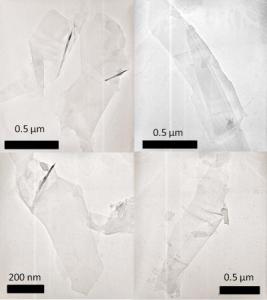Jun 22 2010
Researchers at Rensselaer Polytechnic Institute have developed a simple new method for producing large quantities of the promising nanomaterial graphene. The new technique works at room temperature, needs little processing, and paves the way for cost-effective mass production of graphene.
An atom-thick sheet of carbon arranged in a honeycomb structure, graphene has unique mechanical and electrical properties and is considered a potential heir to copper and silicon as the fundamental building block of nanoelectronics. Since graphene's discovery in 2004, researchers have been searching for an easy method to produce it in bulk quantities.
 A transmission electron microscope image of the nanomaterial graphene made with a new technique from researchers at Rensselaer.
A transmission electron microscope image of the nanomaterial graphene made with a new technique from researchers at Rensselaer.
A team of interdisciplinary researchers, led by Swastik Kar, research assistant professor in the Department of Physics, Applied Physics, and Astronomy at Rensselaer, has brought science a step closer to realizing this important goal. By submerging graphite in a mixture of dilute organic acid, alcohol, and water, and then exposing it to ultrasonic sound, the team discovered that the acid works as a "molecular wedge" which separates sheets of graphene from the parent graphite. The process results in the creation of large quantities of undamaged, high-quality graphene dispersed in water. Kar and team then used the graphene to build chemical sensors and ultracapacitors.
"There are other known techniques for fabricating graphene, but our process is advantageous for mass production as it is low cost, performed at room temperature, devoid of any harsh chemicals, and thus is friendly to a number of technologies where temperature and environmental limitations exist," Kar said. "The process does not need any controlled environment chambers, which enhances its simplicity without compromising its scalability. This simplicity enabled us to directly demonstrate high-performance applications related to environmental sensing and energy storage, which have become issues of global importance."
Results of the study, titled "Stable Aqueous Dispersions of Non-Covalently Functionalized Graphene from Graphite and their Multifunctional High-Performance Applications," were published online Thursday, June 17, 2010, by the journal Nano Letters.
Graphene eluded scientists for years but was finally made in the laboratory in 2004 with the help of a common office supply – clear adhesive tape. Graphite, the common material used in most pencils, is made up of countless layers of graphene. Researchers at first simply used the gentle stickiness of tape to pull layers of graphene from a piece of graphite.
Today, graphene fabrication is much more sophisticated. The most commonly used method, however, which involves oxidizing graphite and reducing the oxide at a later stage in the process, results in a degradation of graphene's attractive conductive properties, Kar said. His team took a different route.
The researchers dissolved 1-pyrenecarboxylic acid (PCA) in a solution of water and methanol, and then introduced bulk graphite powder. The pyrene part of PCA is mostly hydrophobic, and clings to the surface of the also-hydrophobic graphite. The mixture is exposed to ultrasonic sound, which vibrates and agitates the graphite. As the molecular bonds holding together the graphene sheets in graphite start to weaken because of the agitation, the PCA also exploits these weakening bonds and works its way between the layers of graphene that make up the graphite. Ultimately, this coordinated attack results in layers of graphene flaking off of the graphite and into the water. The PCA also helps ensure the graphene does not clump and remains evenly dispersed in the water. Water is benign, and is an ideal vehicle through which graphene can be introduced into new applications and areas of research, Kar said.
"We believe that our method also will be useful for applications of graphene which require an aqueous medium, such as biomolecular experiments with living cells, or investigations involving glucose or protein interactions with graphene," he said.
Using ultrathin membranes fabricated from graphene, the research team developed chemical sensors that can easily identify ethanol from within a mixture of different gases and vapors. Such a sensor could possibly be used as an industrial leakage detector or a breath-alcohol analyzer. The researchers also used the graphene to build an ultra-thin energy-storage device. The double-layer capacitor demonstrated high specific capacitance, power, and energy density, and performed far superior to similar devices fabricated in the past using graphene. Both devices show great promise for further performance enhancements, Kar said.
Source: http://www.rpi.edu/